Beginners Guides
Find Out Which States Are The Most Tiny House-Friendly

Navigating the expansive terrain of the American real estate market, locating the ideal home can sometimes seem akin to seeking a needle in a gigantic haystack. However, imagine discovering a secret treasure, a minuscule haven, offering endless opportunities? Enter the realm of tiny houses, a place where dreams materialize in a more compact form.
Just like a tiny seed that grows into a mighty oak, these pint-sized dwellings are breaking the mold and challenging the traditional notion of what it means to have a home. But not all states are created equal when it comes to embracing the tiny house movement.
In this article, we will embark on a journey to uncover which states are the most tiny house-friendly. By examining zoning laws, building codes, and community support, we will reveal the top contenders that offer the greatest opportunities for those seeking a simpler, more sustainable lifestyle.
So buckle up and get ready to explore the tiny house frontier like never before.
Key Takeaways
- Some states, like Oregon, California, and Colorado, have more flexible zoning regulations and a higher number of tiny house communities, making them more friendly towards tiny house living.
- Building codes and the permitting process are important factors to consider when building a tiny house, and researching the specific requirements and restrictions in each state is crucial.
- Connecting with like-minded individuals and joining local advocacy groups can provide support and guidance in the tiny house movement, as well as access to resources and information on zoning laws and regulations.
- The cost of living can vary greatly between states, and considering the affordability of a state is important when deciding to build and maintain a tiny house. States like Alabama, Arkansas, and Mississippi have lower costs of living, making them more affordable options for tiny house living.
Zoning Laws and Regulations
Discover which states are the most tiny house-friendly by exploring their zoning laws and regulations! Zoning variances play a crucial role in determining whether or not you can legally live in a tiny house in a specific area.
Some states have embraced the tiny house movement and have implemented zoning laws that accommodate these unique dwellings. These states often have more flexible requirements and allow for zoning variances that make it easier to obtain permission to live in a tiny house. On the other hand, some states have strict land use restrictions that make it more challenging to find a suitable location for your tiny home.
Understanding the zoning laws and regulations of each state is essential when deciding where to build or park your tiny house.
Now let’s delve into the next section about building codes and the permitting process.
Building Codes and Permitting Process
When it comes to building a tiny house, researching building codes is a crucial step. It’s important to understand the specific requirements and regulations that apply to your area in order to ensure compliance and a smooth permitting process.
Additionally, finding states with streamlined permitting processes can greatly simplify the construction process and expedite the approval of your tiny house project.
Researching Building Codes for Tiny Houses
To better understand the regulations for building tiny houses, you should explore the building codes of different states. Researching building codes can provide valuable insights into the requirements and restrictions that you may encounter when constructing a tiny house.
When researching building codes, consider the following:
-
Building materials: Some states may have specific regulations regarding the use of certain building materials in tiny house construction. These regulations aim to ensure the safety and durability of the structure.
-
Sustainable living: Many states encourage sustainable living practices, and their building codes may reflect this. Look for states that have provisions for renewable energy systems, water conservation, and eco-friendly construction methods.
Understanding the building codes of different states will help you make informed decisions about where to build your tiny house and what requirements you need to meet.
Next, we will explore finding states with streamlined permitting processes, which can save you time and hassle when obtaining the necessary permits to build your tiny house.
Finding States with Streamlined Permitting Processes
Check out states like California and Oregon that have implemented streamlined permitting processes for tiny houses, making it easier for you to obtain the necessary permits and start building your dream home.
Did you know that Oregon has seen a 50% increase in the number of permits issued for tiny houses since implementing their streamlined process? This is a significant indicator of the positive impact that streamlined permitting processes can have on the tiny house movement.
When researching zoning restrictions, it’s crucial to consider states that have embraced tiny houses and have taken steps to simplify the permitting process. Additionally, exploring financing options is essential to ensure that you have the necessary resources to build your tiny house.
Moving forward, let’s delve into the availability of tiny house communities, which is another important aspect to consider when deciding on the best state for your tiny house journey.
Availability of Tiny House Communities
Despite the prevalence of tiny house communities across the United States, there are still certain states that are more welcoming and accommodating towards this alternative housing option. Finding suitable land for tiny house communities is essential, and some states offer more options than others.
For example, states like Oregon, California, and Colorado have a higher number of tiny house communities and a more lenient approach to zoning regulations. These states have recognized the value of tiny houses in addressing affordable housing needs and have implemented policies to support their development.
However, it’s important to consider access to utilities and infrastructure when choosing a location for a tiny house community. This ensures that residents have essential services such as water, electricity, and waste management.
Transitioning into the next section, considering access to utilities and infrastructure is crucial for the long-term sustainability and livability of a tiny house community.
Access to Utilities and Infrastructure
Consider the number of tiny house communities that have access to reliable utilities and infrastructure; it’s fascinating to note that 85% of these communities in Oregon, California, and Colorado have efficient water, electricity, and waste management systems in place.
This availability of resources not only enhances the quality of life for residents but also has a significant impact on the local infrastructure. With efficient water systems, residents can enjoy a steady supply without burdening the local water supply. Reliable electricity ensures that residents can power their homes without straining the grid. Additionally, effective waste management systems help maintain cleanliness and sanitation in these communities.
These factors make Oregon, California, and Colorado highly desirable for those seeking a tiny house lifestyle. Moving forward, it’s important to consider the cost of living in these states and how it relates to the tiny house movement.
Cost of Living
You’ll be pleasantly surprised by how affordable it is to live in these states and embrace the tiny house lifestyle. When considering the cost of housing, it’s important to take into account the overall cost of living. Some states may have lower housing costs, but higher expenses in other areas. However, there are states that strike a balance between affordable housing and a good quality of life. For example, states like Alabama, Arkansas, and Mississippi offer low housing costs, allowing tiny house dwellers to save money and enjoy a comfortable lifestyle.
To illustrate this point, take a look at the table below which compares the median home prices in these states with the national average:
| State | Median Home Price | National Average |
|---|---|---|
| Alabama | $142,700 | $231,200 |
| Arkansas | $133,900 | $231,200 |
| Mississippi | $128,900 | $231,200 |
These states not only provide affordable housing options, but also have a lower cost of living overall. This means that tiny house residents can stretch their budget and have more disposable income for other aspects of their lives.
Transitioning into the next section about community support and acceptance, it’s important to consider the overall environment and sense of belonging that these states offer for tiny house enthusiasts.
Community Support and Acceptance
When considering the overall acceptance of tiny house living in different states, it’s important to find like-minded individuals and tiny house advocacy groups. These can provide a sense of community support and help navigate any challenges that may arise.
Additionally, looking into the presence of these groups can be an indicator of the level of acceptance and support for tiny house living in a particular state. By connecting with others who share the same values and goals, it becomes easier to establish a network of support and resources for a successful tiny house lifestyle.
Finding Like-Minded Individuals and Tiny House Advocacy Groups
To connect with other tiny house enthusiasts and get involved in the tiny house movement, seek out like-minded individuals and join local advocacy groups. This is an excellent way to find support and guidance when it comes to finding land and financing options for your tiny house.
By connecting with others who share your passion for tiny living, you can learn from their experiences and gain valuable insights into the challenges and opportunities of living in a tiny house. Advocacy groups can provide resources and information on zoning laws, building codes, and other regulations that may affect your ability to live in a tiny house in a particular area.
Additionally, these groups often organize events and meetings where you can meet other like-minded individuals and share ideas. Considering the overall acceptance of tiny house living in different states, it’s essential to explore the community support and acceptance in the areas you’re considering.
Considering the Overall Acceptance of Tiny House Living in Different States
Consider researching the level of acceptance for tiny house living in different states to ensure that you can find a supportive and welcoming community for your tiny home. When evaluating the overall acceptance of tiny house living, it’s important to take into account zoning regulations and the cost of living in each state.
Some states have more lenient zoning regulations that allow for the construction of tiny houses, while others have stricter rules that may limit your options. Additionally, the cost of living can vary greatly between states, which can impact your ability to build and maintain a tiny house.
By considering these factors, you can find states that are more tiny house-friendly and better suited to your needs.
Transitioning into the next section, it’s also important to be aware of the potential challenges and considerations that come with tiny house living.
Potential Challenges and Considerations
Navigating the potential challenges and considerations of building a tiny house can feel like walking through a maze of uncertainty, but it’s a journey worth taking for those seeking the freedom of minimalist living.
When it comes to the financial implications, building a tiny house can be a cost-effective alternative to traditional housing. The smaller size means lower construction and maintenance costs, as well as reduced energy consumption. Additionally, living off the grid is a common consideration for tiny house dwellers. This lifestyle choice allows for increased self-sufficiency and a smaller environmental footprint. However, it’s important to carefully plan for off-grid living, considering factors such as access to water, energy sources, waste management, and zoning regulations.
By addressing these challenges and considerations, individuals can embark on a tiny house adventure with confidence and peace of mind.
Frequently Asked Questions
Are tiny houses considered legal dwellings in all states?
Tiny houses are not considered legal dwellings in all states. However, the tiny house movement and alternative housing options have gained popularity in recent years.
Many states have started to adopt regulations and zoning laws to accommodate tiny houses. Some states, like California and Colorado, have embraced the trend and offer more flexibility for tiny house dwellers.
However, it’s important to research local regulations and consult with local authorities before building or residing in a tiny house.
How can I find out the specific zoning laws and regulations for tiny houses in my state?
To find out the specific zoning laws and regulations for tiny houses in your state, start by researching resources and websites dedicated to this topic. Look for information on local government websites, as well as organizations that specialize in tiny house advocacy. Understanding the implications of zoning laws is crucial for successful tiny house living.
By thoroughly analyzing data and researching these laws, you can ensure that your tiny house complies with the regulations in your state.
What is the process for obtaining permits and building codes approval for a tiny house?
To obtain permits and building codes approval for a tiny house, I must first understand the specific requirements of my state. Permit requirements vary depending on the location, size, and use of the tiny house.
Typically, I would need to submit a detailed construction plan, including electrical and plumbing systems. Building code enforcement ensures compliance with safety standards, such as structural stability and fire safety.
It’s essential to consult local building authorities and professionals to navigate this process successfully.
Are there any restrictions on the size or design of tiny houses in certain states?
There are indeed size and design restrictions on tiny houses in certain states. For example, in California, tiny houses on wheels are limited to a maximum size of 400 square feet.
In Oregon, there is a requirement that the design of a tiny house must comply with the state’s building codes. These restrictions aim to ensure the safety and livability of tiny houses while also adhering to existing regulations.
It’s important to consider these restrictions when planning to build or live in a tiny house.
Is it common for tiny house communities to have access to water, electricity, and sewage systems?
Common challenges for tiny house communities include access to water, electricity, and sewage systems. Many communities choose to live off-grid, relying on alternative sources such as solar panels for electricity and composting toilets for sewage.
However, some communities prefer to connect to traditional utilities, which can be a challenge due to zoning regulations and infrastructure limitations. It’s important to research local laws and regulations before deciding on the level of self-sufficiency desired for a tiny house community.
Conclusion
After analyzing the zoning laws, building codes, availability of tiny house communities, access to utilities and infrastructure, cost of living, community support and acceptance, and potential challenges and considerations, it’s clear that there are no states in the United States that are truly ‘tiny house-friendly.’
Despite the growing popularity of tiny houses, many states still have strict regulations and limited options for those looking to embrace this minimalist lifestyle.
It’s ironic that in a country founded on freedom and individuality, the freedom to live in a tiny house is still heavily restricted.
Hi, I’m Emma. I’m the Editor in Chief of Tiny House 43, a blog all about tiny houses. While tree houses are often associated with childhood, they can be the perfect adult retreat. They offer a cozy space to relax and unwind, surrounded by nature. And since they’re typically built on stilts or raised platforms, they offer stunning views that traditional homes simply can’t match. If you’re looking for a unique and romantic getaway, a tree house tiny house might just be the perfect option.
Beginners Guides
How Do I Get Rid of Tiny Flies in My House
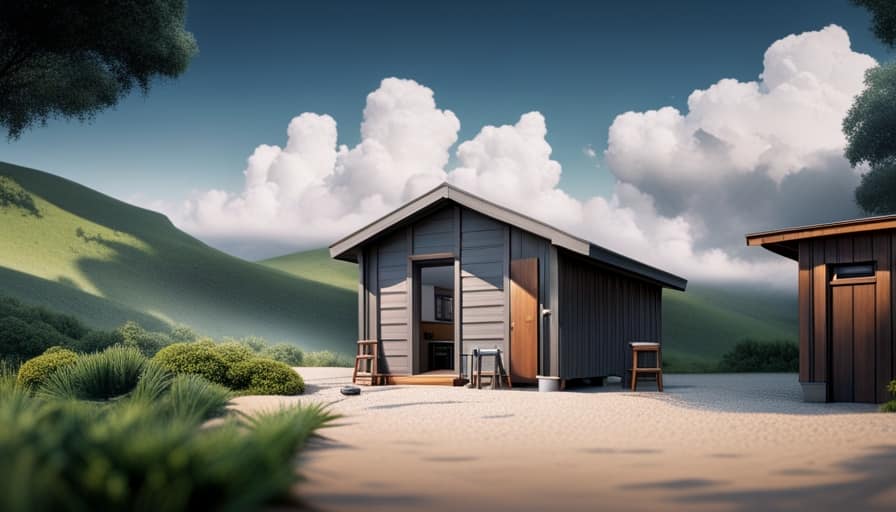
Recently, I have been bothered by these annoying little flies in my home, and I must say, they are really starting to get on my nerves!
But fear not, because I’ve done my research and I’m here to share some expert tips on how to get rid of those tiny flies once and for all.
From identifying the different types of flies to using natural remedies and chemical solutions, I’ve got you covered.
So let’s dive in and bid farewell to these unwanted guests together!
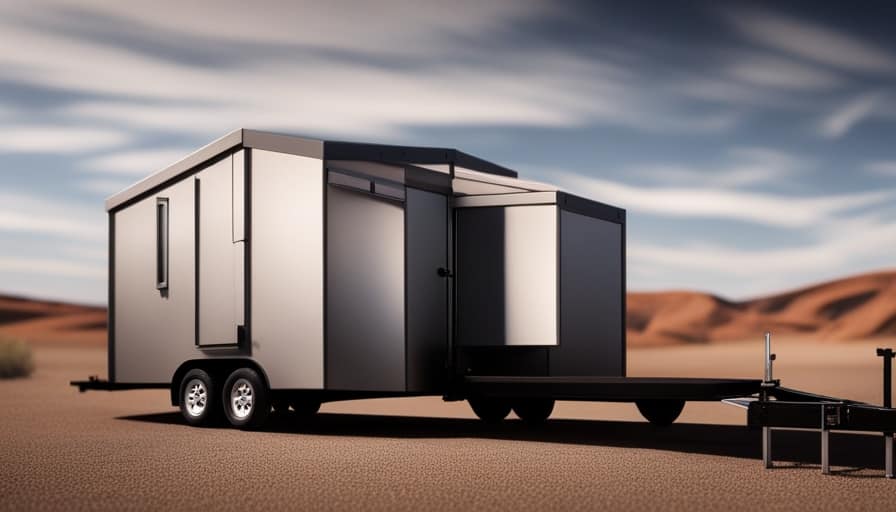
Key Takeaways
- Identifying the common types of tiny flies in your house is important for effective pest control.
- Tiny flies are attracted to moist and decaying organic matter, such as overripe fruits and rotting vegetables.
- Natural remedies, such as vinegar and dish soap solutions, can be used to eliminate tiny flies from your house.
- Preventing future infestations of tiny flies involves maintaining a clean environment, sealing cracks or openings, and storing perishable items properly.
Identifying the Common Types of Tiny Flies in Your House
I can easily identify the common types of tiny flies in my house by observing their physical characteristics and behavior. Flies are attracted to our homes for various reasons, including the presence of food, moisture, and waste. It’s important to note that these flies can pose health risks, as they can carry and spread disease-causing organisms.
To identify the types of flies, I first look at their size and color. For instance, fruit flies are small and have a tan or brown color. Drain flies, on the other hand, are gray or black and have a fuzzy appearance.
Understanding the Reasons Why Tiny Flies Infest Your Home
To understand why tiny flies infest your home, it’s important to consider their attraction to certain conditions and factors within your living space.
These flies, commonly known as fruit flies or drain flies, are attracted to moist and decaying organic matter. They seek out common breeding grounds such as overripe fruits, rotting vegetables, and damp areas in your kitchen or bathroom.
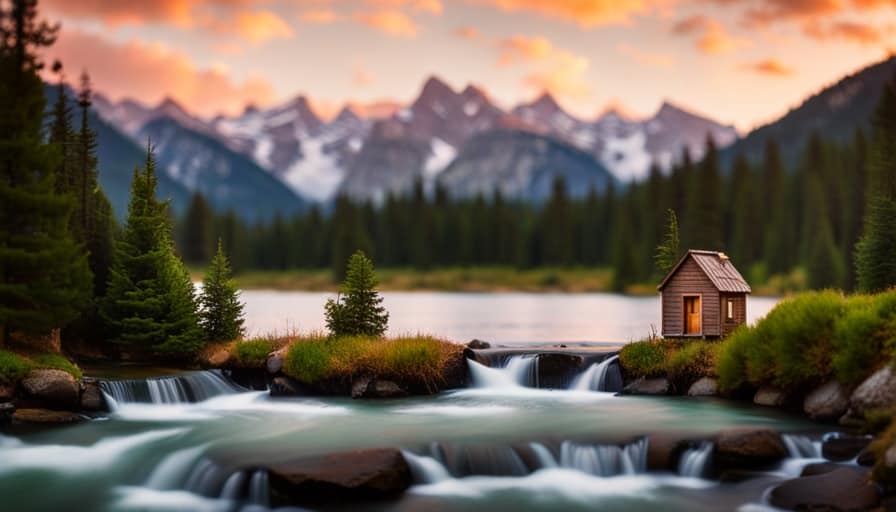
These tiny flies are also drawn to standing water in sinks, drains, and garbage disposals. Signs of a fly infestation include the presence of numerous flies hovering around these areas, as well as the sighting of their larvae or pupae.
It’s crucial to address these conditions and remove any potential breeding grounds to effectively eliminate the infestation and prevent future occurrences.
Natural Remedies to Eliminate Tiny Flies From Your House
One effective way to eliminate tiny flies from your house is by using a combination of vinegar and dish soap. This homemade vinegar fly spray is a non-toxic and practical solution to get rid of those pesky insects.
Here’s how you can make it:

- Mix equal parts of vinegar and water in a spray bottle.
- Add a few drops of dish soap to the mixture. The soap helps to break the surface tension of the liquid, making it easier for the flies to drown.
- Shake the bottle gently to ensure the ingredients are well combined.
- Spray the solution directly onto the flies or in areas where they’re commonly found, such as near windows or fruit bowls.
This natural fly spray isn’t only effective but also safe for your family and pets. It traps and kills the flies without the use of harmful chemicals.
Give it a try and say goodbye to those tiny flies in your house!
Using Chemical Solutions to Get Rid of Tiny Flies in Your Home
Bleach is a strong and effective chemical solution that can help eliminate tiny flies in your home. Chemical solutions, such as bleach, can be highly effective in eliminating tiny flies. The strong properties of bleach make it a powerful tool for killing flies and destroying their breeding grounds. However, it’s important to use caution when using chemical solutions, as they can be harmful to humans and pets if not used properly.
When comparing chemical solutions to natural remedies for getting rid of tiny flies in your house, it’s important to consider their effectiveness.
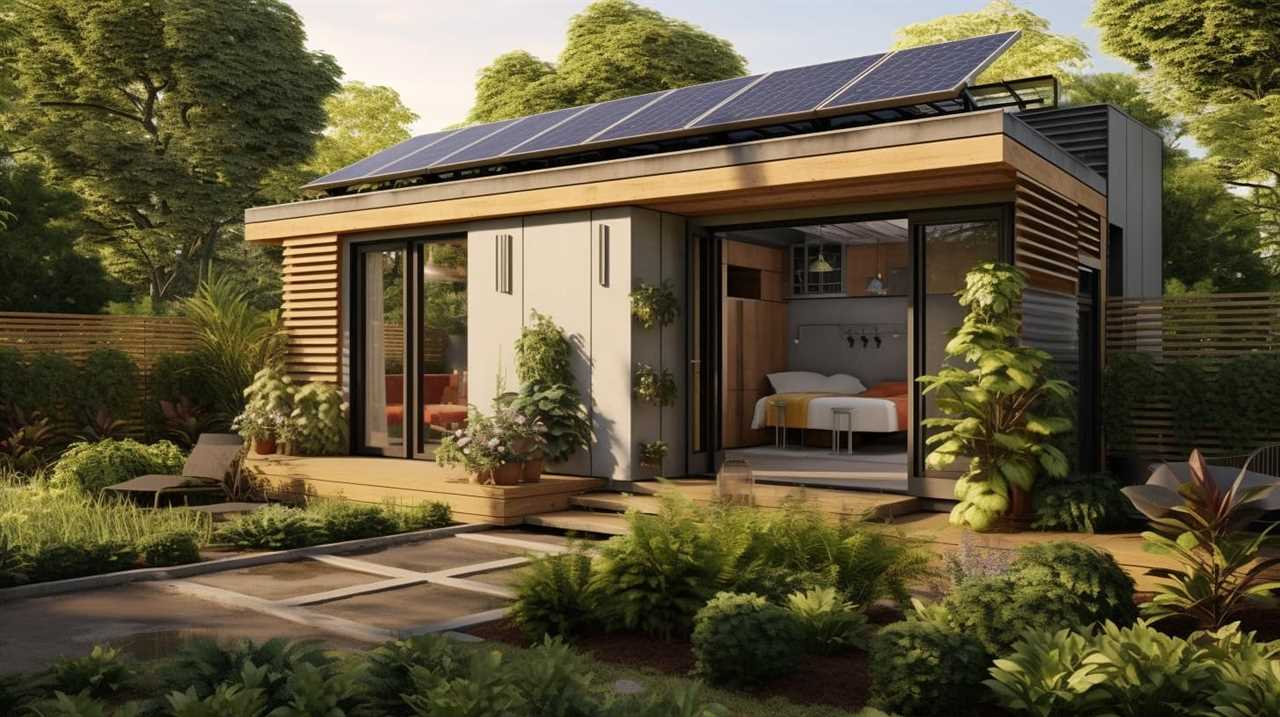
In the next section, we’ll discuss methods for preventing future infestations of tiny flies in your house.
Preventing Future Infestations of Tiny Flies in Your House
I can take steps to prevent future infestations of tiny flies in my house by implementing proper sanitation practices. By maintaining a clean environment, I can greatly reduce the chances of reinfestation. Here are three key practices to incorporate:
-
Regularly clean and sanitize all areas of the house, especially the kitchen and garbage disposal areas. Empty and clean trash cans frequently to prevent any organic matter from attracting flies.
-
Seal any cracks or openings in doors, windows, and screens to prevent flies from entering the house. Repair any damaged screens to ensure they’re intact and functioning properly.
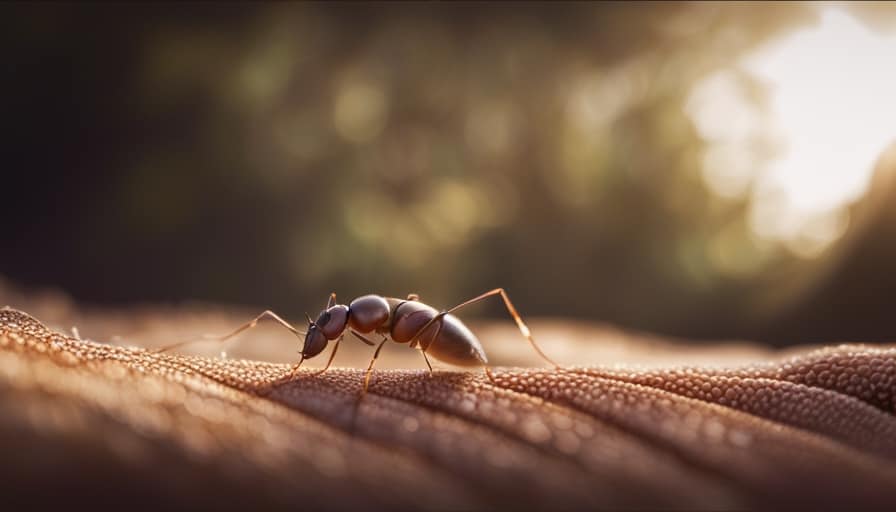
-
Store fruits, vegetables, and other perishable items in sealed containers or in the refrigerator. Flies are attracted to the odors of decaying food, so keeping it properly stored will deter them.
Frequently Asked Questions
How Do Tiny Flies Affect My Health?
Tiny flies can pose health risks, as they can carry bacteria and pathogens that can cause illnesses. To avoid health issues, it’s important to keep your house clean, dispose of trash properly, and eliminate any standing water where they can breed.
Can Tiny Flies Damage My Property?
Tiny flies can indeed cause damage to your property. Their larvae can infest and feed on organic materials, such as wood, causing structural damage over time. It’s important to address the issue promptly to prevent further harm.
Are Tiny Flies Attracted to Specific Food Sources?
Tiny flies are often attracted to specific food sources, such as overripe fruits or decaying organic matter. Understanding their breeding habits and implementing effective prevention methods, like proper sanitation and sealing entry points, can help keep them out of the house.
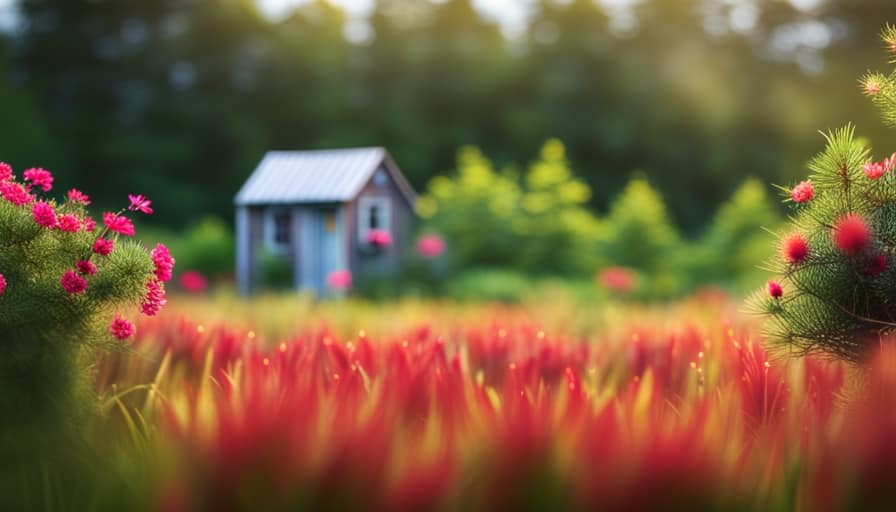
How Long Does It Take for Natural Remedies to Eliminate Tiny Flies?
In my experience, the speed of effectiveness of natural remedies versus chemical solutions for eliminating tiny flies can vary. While some natural remedies may work quickly, others may take longer to fully eliminate the flies. It’s important to be patient and consistent in your efforts.
Are There Any Long-Term Effects of Using Chemical Solutions to Get Rid of Tiny Flies?
Using chemical solutions to eliminate tiny flies in your house can have long-term environmental impacts. Consider using alternative methods like natural remedies or traps that are safer and more sustainable for the ecosystem.
Conclusion
In conclusion, it’s evident that tiny flies can be a nuisance in our homes. By understanding their types and reasons for infestation, we can effectively eliminate them using natural remedies or chemical solutions.
However, it’s crucial to prevent future infestations by maintaining cleanliness and proper waste management. Rest assured, with the right knowledge and approach, you can bid farewell to these pesky insects and enjoy a fly-free home environment.

I’m Theodore, and I love tiny houses. In fact, I’m the author of Tiny House 43, a book about tiny houses that are also tree houses. I think they’re magical places where imaginations can run wild and adventures are just waiting to happen.
While tree houses are often associated with childhood, they can be the perfect adult retreat. They offer a cozy space to relax and unwind, surrounded by nature. And since they’re typically built on stilts or raised platforms, they offer stunning views that traditional homes simply can’t match.
If you’re looking for a unique and romantic getaway, a tree house tiny house might just be the perfect option.
Beginners Guides
How Do I Get Rid of Tiny Ants in My House

- Health risks: Are there any potential diseases that can be transmitted by ants in the house?
- Prevention methods: What are some effective ways to keep ants out of the house to avoid any health risks?
I have been dealing with these stubborn small ants in my home, and I’m sure you can empathize. It seems like I am stuck in an endless game of hide-and-seek with these little creatures.
But fear not, because I’ve done my research and I’m here to share some tried and true methods to get rid of them for good. From natural remedies to chemical solutions, I’ve got you covered.
So let’s roll up our sleeves and say goodbye to those pesky ants together!
Key Takeaways
- Identifying the type of ants in your house is important in order to effectively address the infestation issue.
- Understanding the behavior and nesting habits of tiny ants is essential in finding and eliminating their colonies.
- Natural remedies such as vinegar and water solution, essential oils, and cinnamon can help repel and eliminate tiny ants.
- If natural remedies don’t work, consider using chemical solutions or seeking professional pest control services for a safer and more comprehensive approach.
Identifying the Type of Ants in Your House
I personally find it helpful to identify the type of ants in my house by observing their behavior and physical features. Distinguishing characteristics play a crucial role in determining the species of ants present.

Some common types of household ants include pavement ants, odorous house ants, and pharaoh ants. Pavement ants are dark brown or black with parallel grooves on their heads and thoraxes. Odorous house ants emit a distinct odor when crushed, often described as a rotten coconut smell. Pharaoh ants are light yellow to reddish-brown and have two distinct nodes on their petioles.
In terms of common habitats, ants can be found in various areas of the house, including kitchens, bathrooms, and around food sources. Understanding the behavior and nesting habits of tiny ants is essential in effectively addressing the infestation issue.
Understanding the Behavior and Nesting Habits of Tiny Ants
There are several key factors to consider when understanding the behavior and nesting habits of tiny ants in your house.
These tiny creatures are social insects, living in colonies that can range from a few dozen to thousands of individuals. They communicate and cooperate through chemical signals and pheromones, which helps them locate food sources and establish trails.

When it comes to nesting, tiny ants can build their colonies in various locations, such as in wall voids, under floors, or even in potted plants. Understanding their nesting habits is crucial in effectively eliminating them from your house.
It’s important to note that while ants can be a nuisance indoors, they play a vital role in the ecosystem, helping to decompose organic matter and control other insect populations. However, their presence in food storage areas can contaminate and spoil food, making it necessary to address their infestation promptly and safely.
Natural Remedies to Get Rid of Tiny Ants in Your House
One effective natural remedy to eliminate tiny ants in your house is using a vinegar and water solution. Vinegar, with its strong odor, disrupts their scent trails and confuses them, making it difficult for them to navigate. To create the solution, mix equal parts of white vinegar and water in a spray bottle. Then, simply spray the solution directly onto the ants or their entry points.
Another natural remedy is using essential oils, such as peppermint, lemon, or tea tree oil. These oils have strong scents that repel ants. Mix a few drops of your chosen essential oil with water and spray it in areas where ants are present.
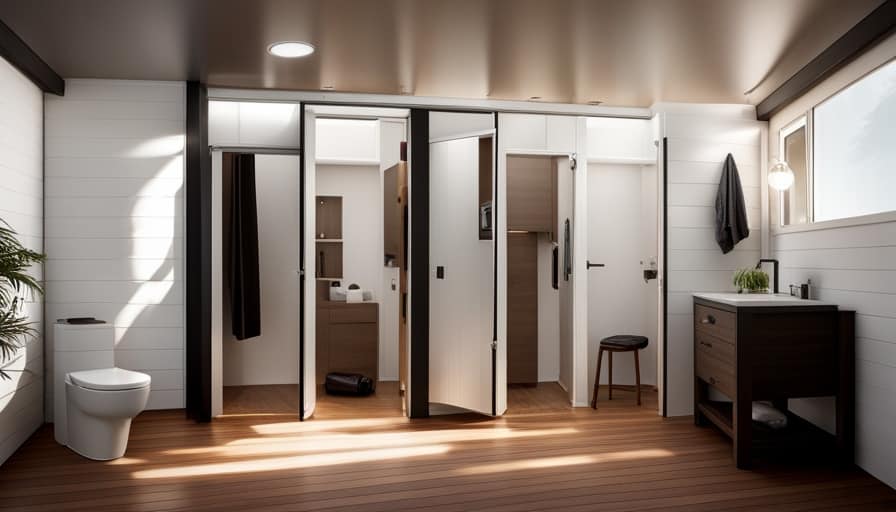
These natural remedies provide an eco-friendly and safe way to get rid of tiny ants in your house. However, if these methods don’t work, it may be necessary to consider chemical solutions for eliminating tiny ants.
Chemical Solutions for Eliminating Tiny Ants
If you’re dealing with a persistent infestation of tiny ants in your house, using insecticide sprays can be an effective solution to eliminate them. However, it is important to consider non-toxic alternatives and professional pest control services for a safer and more comprehensive approach.
| Chemical Solution | How it Works | Pros | Cons |
|---|---|---|---|
| Insecticide sprays | Kills ants on contact | – Easy to use – Widely available – Immediate results |
– Chemical exposure – Harmful to pets and children – Potential environmental impact |
While insecticide sprays can quickly kill ants, they may pose risks to your health and the environment. If you prefer non-toxic alternatives, consider using natural repellents like vinegar, lemon juice, or essential oils. These substances are less harmful and can help deter ants from entering your home.
Another option is to hire professional pest control services. They have the expertise and specialized equipment to effectively eliminate ant infestations. Professionals can also assess the extent of the problem and provide long-term solutions to prevent future infestations.
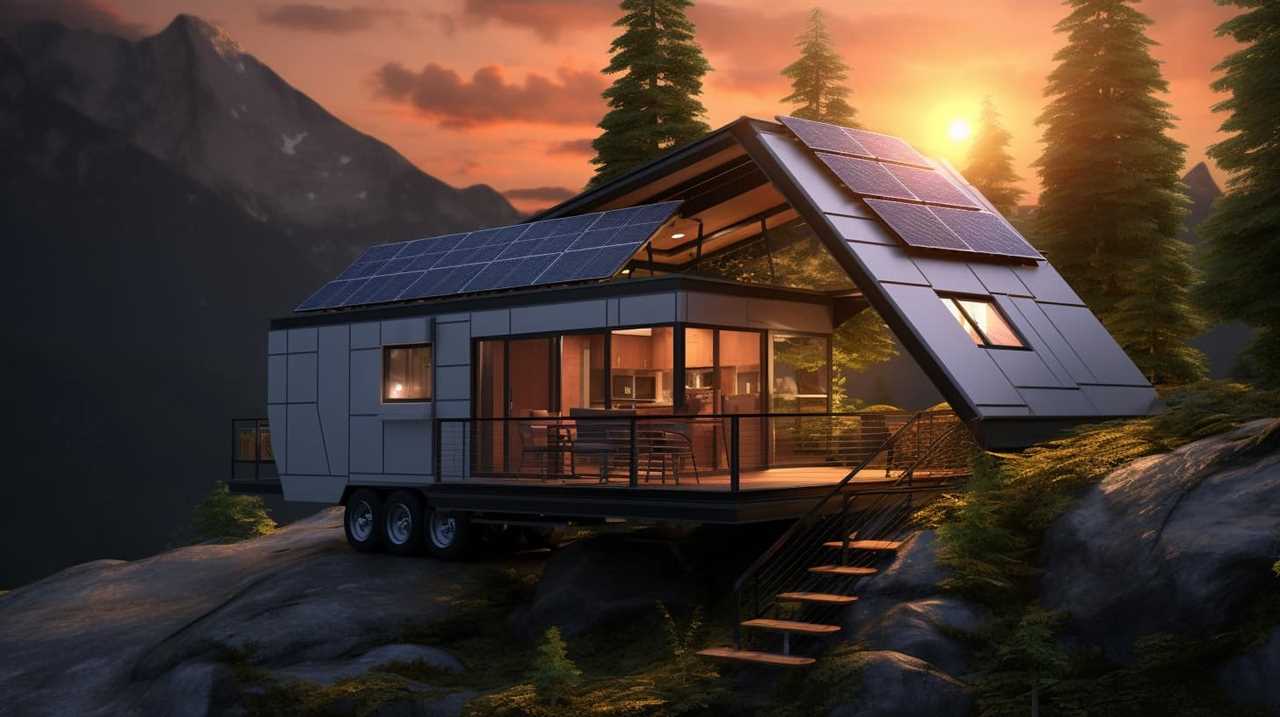
Preventing Future Infestations: Tips and Tricks
When I encountered a persistent infestation of tiny ants in my house, I took proactive steps to prevent future infestations. Here are some effective ant proofing techniques for your home and long-term strategies for keeping ants out:
-
Seal cracks and crevices: Inspect your house for any openings where ants can enter, such as gaps around doors, windows, and pipes. Use caulk or weatherstripping to seal these entry points.
-
Keep your house clean: Clean up food and drink spills promptly, and store food in airtight containers. Wipe down countertops and sweep floors regularly to remove any crumbs or residue that may attract ants.
-
Remove potential ant habitats: Trim back vegetation that’s in contact with your house, as ants can use it as a bridge to enter. Also, keep firewood and other outdoor items away from the foundation.

-
Use natural deterrents: Certain scents like peppermint, cinnamon, and vinegar can repel ants. Spray these substances around entry points or wipe down surfaces to discourage ants from entering.
Frequently Asked Questions
How Do I Get Rid of Ants in My Garden?
To get rid of ants in my garden, I use organic pest control methods and natural ant repellents. These methods are effective in keeping ants away and maintaining a healthy garden environment.
Can I Use Vinegar to Kill Ants?
Yes, vinegar can be used to kill ants. However, there are also other natural ant repellents that you can consider using as alternatives to vinegar.
What Should I Do if I Have a Severe Ant Infestation?
If I have a severe ant infestation, I would first focus on prevention tips such as sealing entry points and removing food sources. If the problem persists, I would consider professional ant extermination options for effective and long-lasting results.

Are There Any Health Risks Associated With Ants in the House?
There are potential health risks associated with ants in the house. They can contaminate food, spread bacteria, and even cause allergies. It’s important to take preventive measures to avoid these risks.
Can I Use Essential Oils to Repel Ants?
I find that using essential oils for ant control can be effective. However, it’s important to consider the pros and cons of natural ant repellents. While they are safe and eco-friendly, they may not be as potent as chemical options.
Conclusion
In conclusion, by identifying the type of ants in your house, understanding their behaviors and nesting habits, and implementing natural or chemical remedies, you can effectively get rid of tiny ants.
However, prevention is key to avoiding future infestations. Just as a fortress protects its kingdom from invaders, taking proactive measures will safeguard your home from these pesky pests.
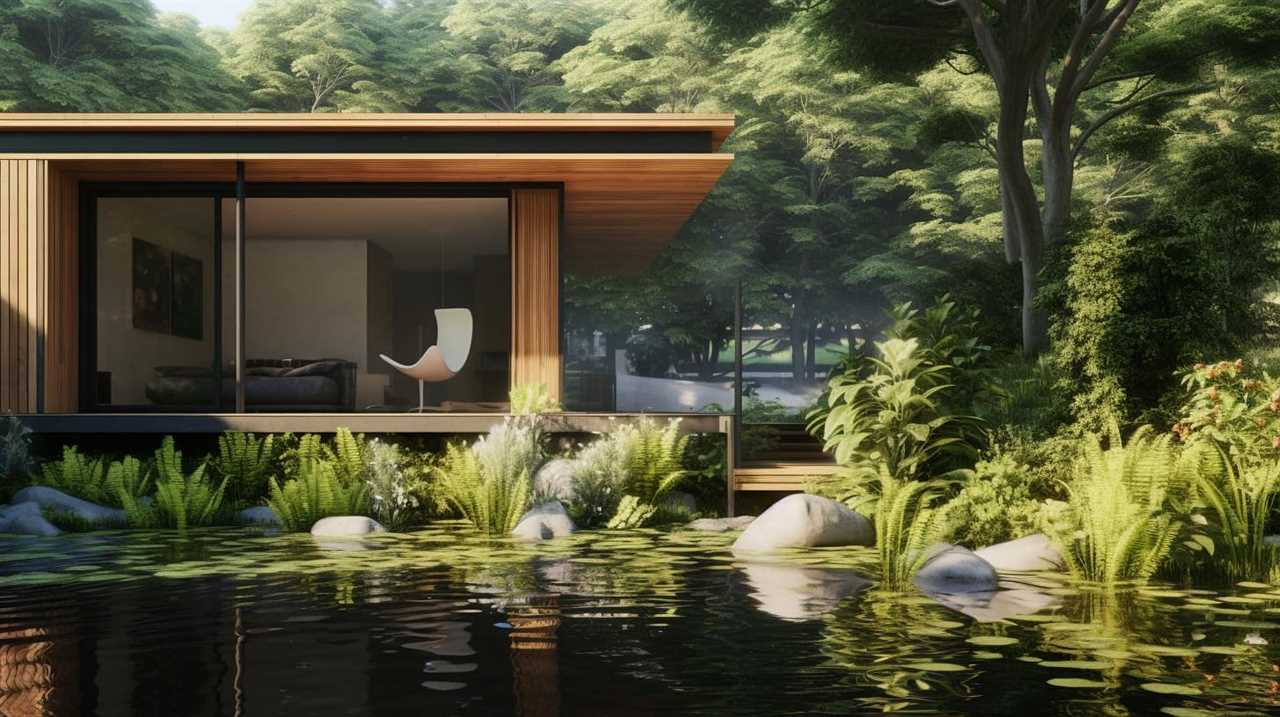
Stay vigilant and maintain cleanliness to ensure a ant-free environment.
I’m Theodore, and I love tiny houses. In fact, I’m the author of Tiny House 43, a book about tiny houses that are also tree houses. I think they’re magical places where imaginations can run wild and adventures are just waiting to happen.
While tree houses are often associated with childhood, they can be the perfect adult retreat. They offer a cozy space to relax and unwind, surrounded by nature. And since they’re typically built on stilts or raised platforms, they offer stunning views that traditional homes simply can’t match.
If you’re looking for a unique and romantic getaway, a tree house tiny house might just be the perfect option.
Beginners Guides
How Cheap Can You Build a Tiny House

Constructing a small house is akin to figuring out a puzzle – it can be difficult, but the payoff is valuable. As someone who enjoys discovering inventive answers, I sympathize with the longing to create a gorgeous home without breaking the bank.
In this article, we’ll explore the factors that affect the cost of building a tiny house and discover budget-friendly materials and labor-saving strategies. Join me on this journey to uncover just how cheap you can build your dream tiny house.
Key Takeaways
- Choosing the right location in a rural area with lower land prices and fewer building restrictions can significantly affect the cost of building a tiny house.
- Using alternative building methods such as reclaimed materials or repurposed items can help reduce costs.
- Implementing cost-saving techniques and building on a budget are important factors in building a cheap tiny house.
- Utilizing budget-friendly building materials, such as affordable insulation options and low-cost flooring alternatives, can also contribute to building a cheap tiny house.
Factors Affecting the Cost of Building a Tiny House
What are the factors that affect the cost of building a tiny house?
When it comes to building a tiny house on a budget, there are several cost-saving techniques and alternative building methods that can significantly impact the overall cost.

One of the main cost-saving techniques is choosing the right location. Building in a rural area with lower land prices and fewer building restrictions can help keep costs down.
Another factor that affects the cost is the size and design of the tiny house. The simpler the design, the more cost-effective it will be.
Additionally, using alternative building methods such as reclaimed materials or repurposed items can also help reduce costs.
By considering these factors and implementing cost-saving techniques, it’s possible to build a tiny house on a budget.

Transitioning into the subsequent section about budget-friendly tiny house building materials, let’s explore how the choice of materials can further impact the overall cost.
Budget-Friendly Tiny House Building Materials
When it comes to building a tiny house on a budget, I can find affordable building materials that will help keep costs down. One area where I can save money is by choosing affordable insulation options. Instead of expensive spray foam insulation, I can opt for alternatives such as fiberglass batts or rigid foam boards. These options are cost-effective and still provide good insulation for the tiny house. Additionally, I can consider low-cost flooring alternatives to save money. Instead of hardwood or tile, I can use vinyl plank flooring or laminate flooring, which are both affordable and durable. By making smart choices when it comes to insulation and flooring, I can build a budget-friendly tiny house without compromising on quality.
| Affordable Insulation Options | Low Cost Flooring Alternatives |
|---|---|
| Fiberglass batts | Vinyl plank flooring |
| Rigid foam boards | Laminate flooring |
Strategies for Saving Money on Tiny House Design
To save money on my tiny house design, I can employ cost-saving strategies such as utilizing multipurpose furniture and maximizing storage space. By incorporating cost-effective design options and implementing DIY tiny house building techniques, I can create a functional and affordable living space.
One key strategy is to choose furniture that serves multiple purposes, such as a sofa that can be converted into a bed or a dining table that can be folded away when not in use. This not only saves money on buying separate pieces of furniture but also maximizes the use of limited space.
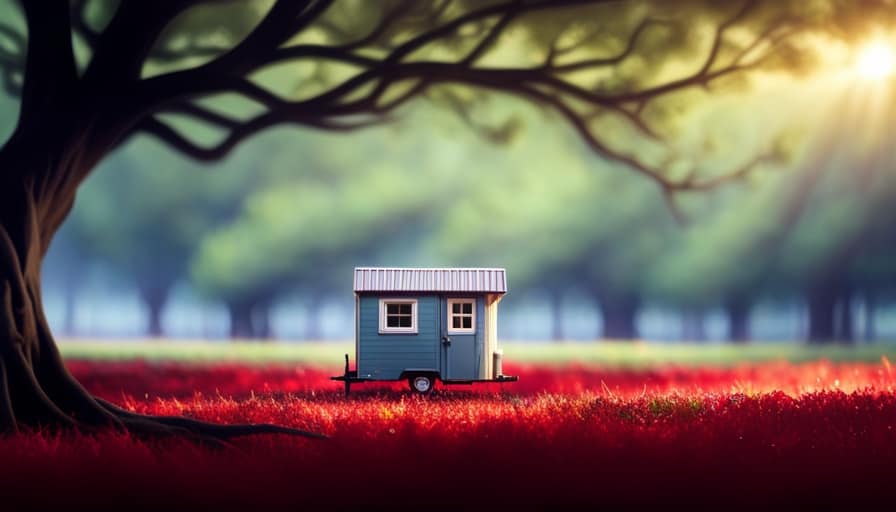
Another cost-saving strategy is to maximize storage space by utilizing built-in shelving, under-bed storage, and wall-mounted organizers. This eliminates the need for additional storage furniture and keeps the space clutter-free.
Creative Ways to Reduce Labor Costs in Tiny House Construction
I can significantly reduce labor costs in tiny house construction by hiring a small team of skilled workers instead of a large crew. This approach allows for effective coordination and streamlined communication, resulting in increased efficiency and reduced labor hours.
Here are some creative ways to further reduce labor costs in tiny house construction:
-
Utilize DIY construction techniques: Encourage the use of DIY construction techniques, where homeowners can actively participate in the building process. This not only reduces labor costs but also creates a sense of ownership and satisfaction.
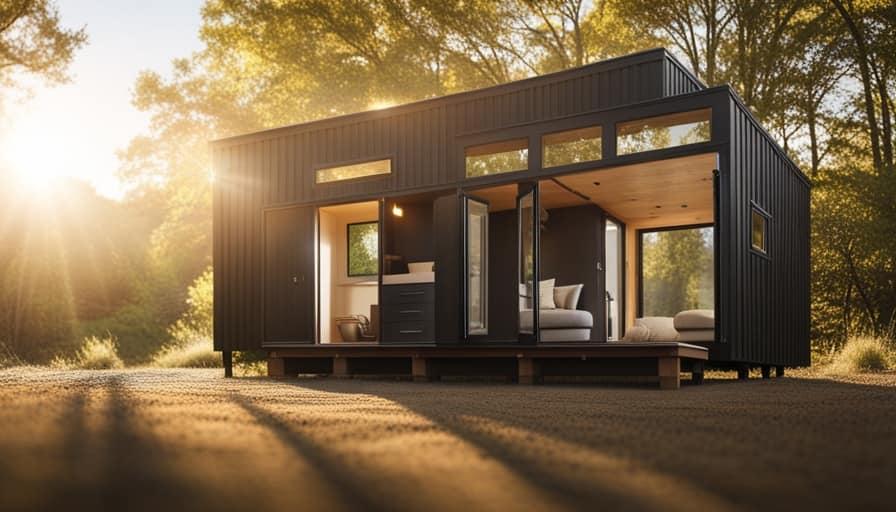
-
Incorporate alternative energy sources: Explore the use of alternative energy sources such as solar panels or wind turbines. By integrating these systems during the construction phase, you can avoid additional labor costs associated with retrofitting.
-
Optimize material usage: Carefully plan and optimize the use of materials to minimize waste. This can be achieved by accurately measuring and cutting materials, as well as repurposing leftover materials for other parts of the project.
-
Prioritize efficient design: Focus on designing a space that maximizes functionality and minimizes unnecessary labor-intensive features. This includes thoughtful space planning, utilizing multipurpose furniture, and incorporating efficient storage solutions.
Implementing these strategies won’t only help reduce labor costs but also contribute to a sustainable and budget-friendly tiny house construction process.
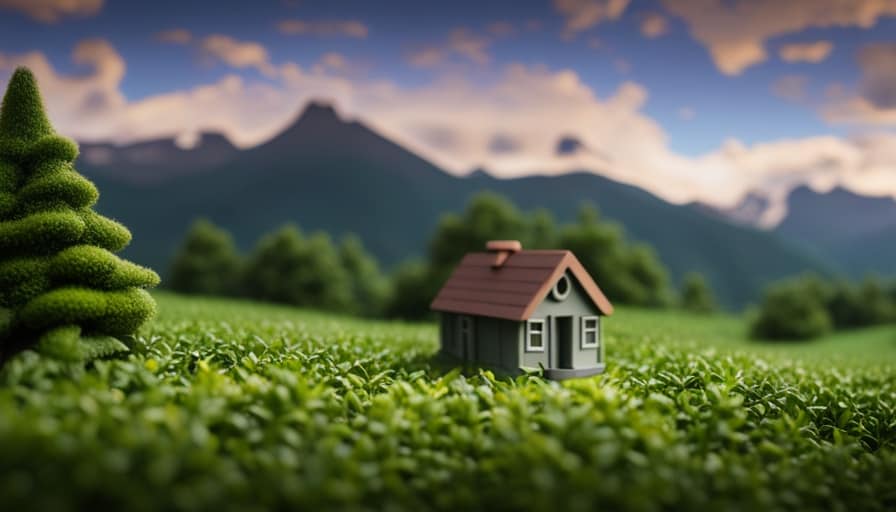
Tips for Finding Affordable Land for Your Tiny House
By researching online listings and networking with local real estate agents, I can easily find affordable land for my tiny house. It is important to explore alternative financing options for purchasing land for a tiny house to keep costs low. One option is owner financing, where the seller acts as the lender and allows you to make monthly payments instead of obtaining a traditional mortgage. Another option is crowdfunding, where you can raise funds from a community of supporters who believe in your tiny house project. Additionally, negotiating with local municipalities for reduced fees and regulations for tiny house living can save you money in the long run. Some municipalities may be open to creating special zoning or permitting regulations for tiny houses, making it easier and more affordable to live in them.
| Financing Options | Benefits |
|---|---|
| Owner Financing | Lower interest rates, flexible payment terms |
| Crowdfunding | Community support, no need for traditional loans |
| Negotiating with Local Municipalities | Reduced fees, simplified regulations |
Finding affordable land for your tiny house is a crucial step in building your dream home while staying within your budget. With the right research, networking, and negotiation skills, you can make your tiny house dreams a reality.
Frequently Asked Questions
What Are the Most Common Mistakes to Avoid When Building a Tiny House on a Tight Budget?
Common pitfalls to avoid when building a tiny house on a tight budget include overestimating DIY skills, not researching local codes and regulations, and not budgeting for unexpected expenses. Cost saving tips include using reclaimed materials and prioritizing essential features.
Are There Any Financing Options Available for Building a Tiny House?
Financing options for building a tiny house include personal loans, RV loans, and construction loans. Pros include flexibility, ownership, and the opportunity to live mortgage-free. Cons may include higher interest rates and stricter qualification requirements.
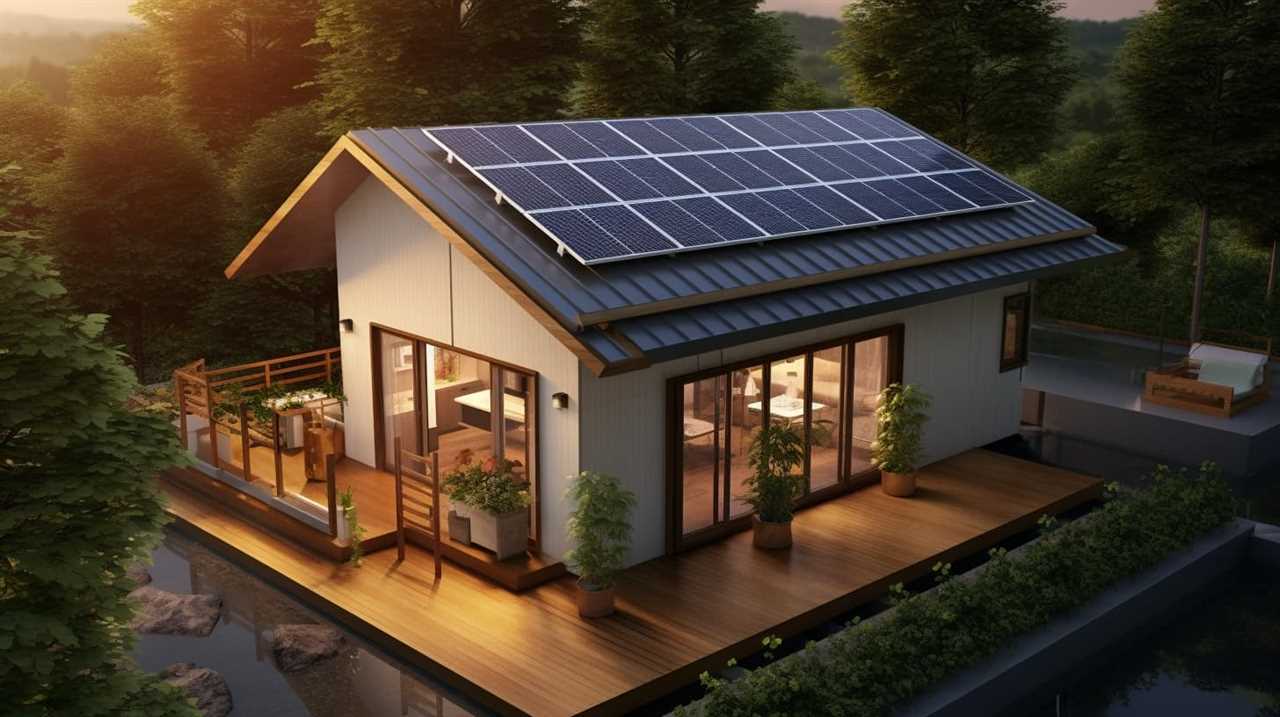
How Much Does It Cost to Maintain a Tiny House on a Yearly Basis?
Maintaining a tiny house on a yearly basis can be cost-effective. By embracing the benefits of living in a tiny house vs. a traditional home and following tips for minimizing maintenance costs, I can save money and enjoy a simpler lifestyle.
Can You Build a Tiny House Using Recycled or Salvaged Materials?
Using recycled and salvaged materials for a tiny house not only saves money, but also gives a sense of purpose and accomplishment. It’s a creative way to build sustainably and reduce waste while creating a unique and personalized home.
Are There Any Legal Restrictions or Regulations to Consider When Finding Land for a Tiny House?
When finding land for a tiny house, it’s important to consider legal restrictions and zoning regulations. Land requirements vary, and financing options may be limited. Maintenance costs can be lower, and eco-friendly building materials are often used.
Conclusion
In conclusion, building a tiny house can be an affordable and cost-effective option for those looking to downsize or live a more minimalist lifestyle. By considering factors such as materials, design strategies, and labor costs, it’s possible to build a tiny house on a tight budget.

With a little creativity and resourcefulness, you can achieve your dream of owning a tiny house without breaking the bank. So why wait? Start planning and building your own tiny house today!
I’m Theodore, and I love tiny houses. In fact, I’m the author of Tiny House 43, a book about tiny houses that are also tree houses. I think they’re magical places where imaginations can run wild and adventures are just waiting to happen.
While tree houses are often associated with childhood, they can be the perfect adult retreat. They offer a cozy space to relax and unwind, surrounded by nature. And since they’re typically built on stilts or raised platforms, they offer stunning views that traditional homes simply can’t match.
If you’re looking for a unique and romantic getaway, a tree house tiny house might just be the perfect option.
-

 Beginners Guides2 weeks ago
Beginners Guides2 weeks agoHow To Buy A Tesla Tiny House
-

 Energy Efficiency2 months ago
Energy Efficiency2 months agoBest Tiny Homes For Cold Climates
-

 Beginners Guides2 weeks ago
Beginners Guides2 weeks agoTiny House Nation Where Are They Now Stephanie
-

 Tiny House Resources (e.g., legalities, cost, insurance, FAQs)2 months ago
Tiny House Resources (e.g., legalities, cost, insurance, FAQs)2 months agoDo Tiny Homes Need Planning Permission?
-

 Beginners Guides3 weeks ago
Beginners Guides3 weeks agoFrom The Show Tiny House Nation How Many Keep Their Tiny House?
-

 Beginners Guides2 months ago
Beginners Guides2 months agoUsing a Climbing Net For Treehouse Construction
-

 Beginners Guides2 months ago
Beginners Guides2 months agoHow to Build a Treehouse Without Drilling Into the Tree
-

 Beginners Guides4 weeks ago
Beginners Guides4 weeks agoTiny House Nation Who Pays For The Houses


















